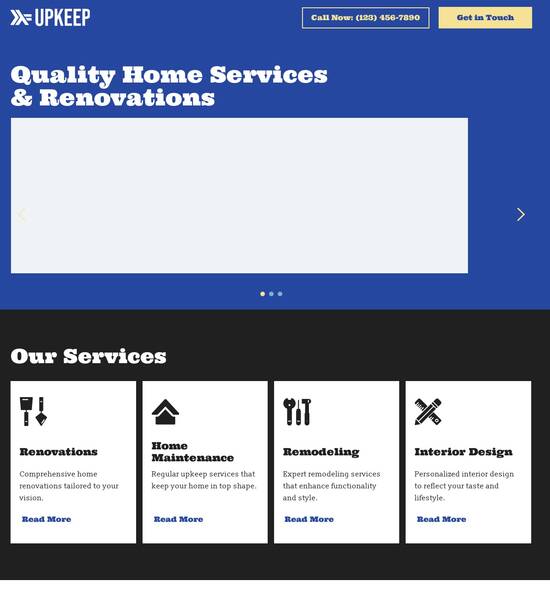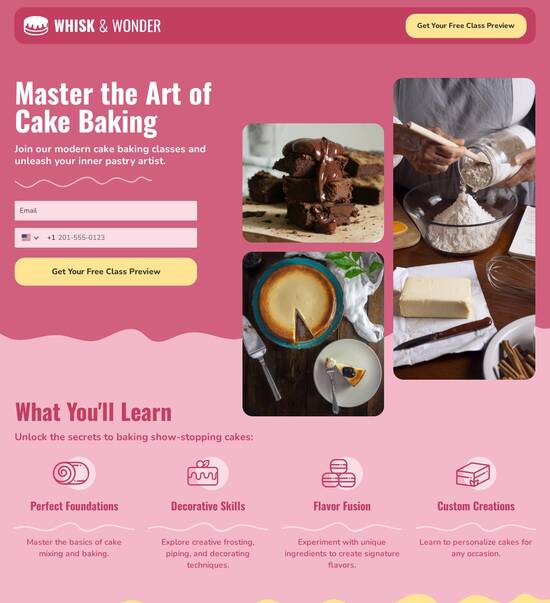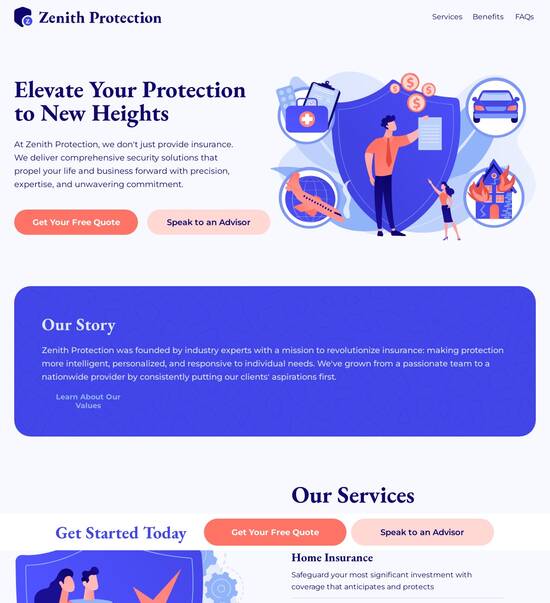
HTML page template for Tile setters
Use TemplateAbout template
Attract clients and showcase your skills with style using our landing page templates for Tile setters. Let's convert those visitors into clients!
Recommended templates

Easy to build without coding
With the intuitive drag-and-drop builder, anyone on your team can create high-converting pages without any knowledge of code or design. Make enhancements to your landing page with custom widgets using Javascript, HTML/CSS, or third-party scripts.

Multiple layouts for any industry and goal
Select from 500+ landing page layouts built to boost conversions across industry-specific scenarios. Customize them by adjusting fonts, adding images, and generating on-brand content with the AI assistant. Quickly scale with Instablocks® and Global Blocks that you can save, reuse, and update globally.

Loads fast and looks polished on any device
Every template is responsive, which means they present professionally on any device and load blazingly fast with our Thor Render Engine. You can also power them up with Google AMP technology to deliver an unparalleled mobile experience and drive higher conversions.

Robust analytics & experimentation
Get real-time updates and reporting across all your devices, showing the number of visitors, conversions, cost-per-visitor, and cost-per-lead. Launch AI-powered experiments, run A/B tests, and use heatmaps to analyze user behavior, then optimize your landing page to maximize conversions.







Easy to build without coding
With the intuitive drag-and-drop builder, anyone on your team can create high-converting pages without any knowledge of code or design. Make enhancements to your landing page with custom widgets using Javascript, HTML/CSS, or third-party scripts.
Multiple layouts for any industry and goal
Select from 500+ landing page layouts built to boost conversions across industry-specific scenarios. Customize them by adjusting fonts, adding images, and generating on-brand content with the AI assistant. Quickly scale with Instablocks® and Global Blocks that you can save, reuse, and update globally.
Loads fast and looks polished on any device
Every template is responsive, which means they present professionally on any device and load blazingly fast with our Thor Render Engine.
Robust analytics & experimentation
Get real-time updates and reporting across all your devices, showing the number of visitors, conversions, cost-per-visitor, and cost-per-lead. Launch AI-powered experiments, run A/B tests, and use heatmaps to analyze user behavior, then optimize your landing page to maximize conversions.
All the features you need to build tiles website template free download
Explore more featuresLearn how to build tile website template
FAQs
Leading the way in building high-performing landing pages





Compelling reasons to select HTML page template for Tile setters
Today's business operations occur more on the web than anywhere else. This increases the significance of having a solid online brand presence. Doing this requires time, experience, and plenty of resources unless you do it with Instapage, a go-to platform for crafting web pages that attract visitors and convert. If you’re searching for a ready-made HTML page template for Tile setters and ways to launch your project quickly and with the highest effect, we're here to help!
The advantages you get using our HTML page template for Tile setters
Instapage is advantageous in many ways. Our solution offers a collection of more than 200 industry-specific landing page templates for any business need. With smooth, modern, and visually attractive designs and strategically placed call-to-action buttons, they’re dressed to impress. Using our user-friendly drag-and-drop editor, you can quickly adjust your HTML page template for Tile setters to reflect your brand. Change colors, modify the layout and background, and add your visual elements and dedicated content to make your future page look exactly like you need.
In addition to page building and editing tools, our platform features A/B testing capabilities, enabling you to check different variations of your web page and identify what resonates best with your target audience. Access the whole spectrum of our optimization features to elevate your brand, maximize engagement, and turn visitors into committed customers. Turn your targets into a reality today with Instapage!
Unleashing potential: Advanced HTML page templates for tile setters
Understanding the role of tile setters in modern design
Tile setters are skilled artisans who specialize in laying tiles in various settings. Their work is essential in transforming spaces—whether in bathrooms, kitchens, or commercial properties—into visually appealing and functional environments. The contributions of tile setters extend beyond aesthetics; they also play a crucial role in providing durability and resilience against wear and tear, ensuring that installations can withstand the test of time. As professionals who combine artistry with technical skills, tile setters help create cohesive designs that resonate with clients' visions.
Over the years, tile setting has evolved dramatically. The methods and designs we see today have roots in historical practices but have been reshaped by advancements in technology. Manual layouts, once the norm, have now taken a backseat to digital design tools that facilitate precision and creativity. This evolution not only streamlines the tile-setting process but also enhances the overall quality and safety of installations.
Fundamental elements of HTML page templates for tile setters
Creating effective HTML page templates for tile setters involves understanding the structure and elements that can enhance both user experience and functionality. One crucial element is the modular structure often referred to as block templates. By breaking down the design into manageable blocks, tile setters can easily create, update, and customize layouts. This modular approach not only simplifies the design process but also enhances maintainability, allowing for seamless adjustments as projects evolve.
Flexibility in design modifications
Quick adaptations for various projects
Ease of maintenance over time
Another transformative technology in tile layout design is Flexbox. This CSS tool revolutionizes layout management, allowing tile setters to distribute space and align items more effectively. Implementing Flexbox involves defining a container to hold tile elements and using properties to control the arrangement dynamically. Not only does this enhance the visual appeal of tile layouts, but it also ensures that designs remain responsive and adaptable to various screen sizes.
Exploring core features of tile setter templates
A significant aspect of modern HTML templates for tile setters is responsive design. In today's multi-device world, ensuring that layouts adapt seamlessly across different screens is paramount. Responsive design techniques include using fluid grid layouts, scalable images, and CSS media queries. These tools ensure that whether a user is viewing a tile layout on a mobile device or a desktop computer, they experience a consistent and visually appealing interface.
Fluid grid layouts for adaptable scaling
Media queries for specific device targeting
Maintained integrity of design across devices
Customization options are another vital feature of tile setter templates. By offering elements like colors, typography, and shapes, tile setters can retain their unique branding and style. This flexibility allows them to tailor their designs according to specific client needs and preferences. Furthermore, various tools and technologies can assist in this process, enabling users to modify their templates without the need for extensive coding knowledge.
Enhancing collaborations with teams and communities
Collaboration is an intrinsic part of the tile-setting process. Using HTML templates, tile setters can enhance teamwork by creating a consistent visual language and streamlining communication among team members. Strategies for effective collaboration include clear documentation regarding template usage and establishing designated roles within the team to manage updates and modifications.
Establish clear documentation for template use
Designate roles for project management
Foster regular check-ins and updates
Engaging with online communities can further enrich the learning experience for tile setters. Platforms like forums and social media groups provide spaces to exchange knowledge, troubleshoot problems, and share innovative ideas. Participating in these communities not only aids personal development but also enhances one's ability to stay updated with industry trends.
Technological integration within tile setter templates
Incorporating advanced web technologies plays a crucial role in optimizing tile setter capabilities. Tools such as CSS grids and JavaScript frameworks provide enhanced flexibility and functionality, allowing for more intricate and visually engaging designs. These technologies can help tile setters develop interactive layouts that not only catch the eye but also improve user engagement.
CSS Grids for complex multi-dimensional layouts
JavaScript frameworks for enhanced interactivity
Tools for creating visually stunning designs
Additionally, content management systems (CMS) integrated into HTML templates facilitate seamless updates to tile layouts. This functionality is particularly beneficial for tile setters who often deal with project changes, allowing for quick and efficient modifications without requiring extensive technical expertise.
Addressing common questions and challenges in tile design
Tile setters often face common concerns related to layout, responsiveness, and customization within their projects. By addressing frequently asked questions, such as methods for ensuring optimal spacing or achieving desirable tile sizes, professionals can enhance their understanding and make informed decisions. Compiling a list of these questions and their corresponding answers can serve as an invaluable resource for tile setters embarking on their design journeys.
How to achieve optimal spacing for tile layouts?
Best practices for responsive design implementation
Customization tips to enhance visual appeal
Overcoming layout challenges requires employing effective troubleshooting techniques. Tile setters can optimize loading times and performance by implementing best practices such as minimizing image sizes and leveraging caching mechanisms. These strategies not only improve user experience but also enhance the overall functionality of tile setter templates.
The future of HTML page templates for tile setters
The landscape of tile layout design is continuously evolving, with emerging trends shaping the future of tile setters. Innovations in materials, techniques, and web technologies are all factors to consider when designing templates. For example, the use of augmented reality for visualizing tile layouts before installation is gaining traction. Keeping an eye on these trends can help ensure that tile setters remain competitive and capable of meeting rising client expectations.
Emerging trends in materials and techniques
Integration of augmented reality applications
Predictions on future trends in digital design
Moreover, the digital landscape presents numerous opportunities for growth within tile setter communities. By leveraging their skills, tile setters can engage in innovative projects that highlight their expertise, from redesigning personal portfolios to collaborating on community-driven initiatives. These efforts not only foster individual development but also enhance the visibility of the tile-setting profession as a whole.
Diverse types of tile layouts and their applications
When it comes to choosing the right type of tile layout, considerations on aesthetics, practical applications, and environments are essential. Various layout styles, such as grid, masonry, and justified layouts, each offer unique visual impacts and practicalities. For instance, grid layouts provide a uniform and predictable structure, ideal for more traditional settings, while masonry styles add a dynamic touch that enhances visual interest in creative designs.
Grid layout is great for traditional environments
Masonry layout enhances creative, informal spaces
Justified layouts offer a modern, asymmetrical appearance
In addition to these design considerations, incorporating interactive features into tile layouts can significantly enhance user engagement. Interactive tiles with buttons and links can guide users toward relevant information, making the browsing experience more enjoyable and user-friendly. This level of interactivity can transform standard layouts into compelling user interfaces that encourage exploration and discovery.
Collecting insights and feedback for continuous improvement
An important strategy for tile setters is collecting user feedback on their designs. Effective methods, such as surveys and usability testing, can help gather insights that are critical for refining layouts and making informed adjustments. By understanding what resonates with users, tile setters can ensure their designs cater effectively to audience preferences.
Conduct surveys to gather user experiences
Utilize usability testing sessions for feedback
Analyze user interaction data for insights
Moreover, utilizing feedback to refine designs is a continuous process. Real-world applications often illustrate the effectiveness of this approach, as user-driven changes can significantly enhance the usability and appeal of tile layouts. Adopting iterative processes allows tile setters to monitor improvements over time and quickly adapt to emerging needs or challenges.
Crafting an impactful landing page with tile setter templates
Creating an effective landing page using tile layouts requires an understanding of key components that contribute to success. Essential elements include a strong visual hierarchy, strategically placed calls to action, and engaging content that resonates with visitors. Together, these components help direct users toward desired outcomes, be it making a purchase, signing up for a newsletter, or exploring more about a service.
Establish a clear visual hierarchy to guide user attention
Incorporate compelling content that addresses audience needs
Ensure CTAs are clearly defined and positioned
Case studies showcasing high-converting landing pages highlight successful implementations that utilize tile setter designs. By analyzing these examples, tile setters can extract invaluable lessons that inform their own strategies, ultimately guiding them to replicate success in their projects. Exploring different approaches and understanding what works well in other contexts can inspire creativity and drive innovation in custom tile layouts.
Ready to skyrocket conversions?
Supercharge your ad campaigns with high-performing landing pages
Get started














